4.2 – Labour Market Equilibrium and Wage Determinants
Learning Objectives
- Employ the marginal decision rule to determine the equilibrium cost of labor
- Describe the factors that determine the wage rate
- Describe nonmonetary factors that affect wage rates
- Identify the relationship between performance and wages
- Explain how wages are determines by marginal revenue productivity
- Discuss the factors that influence the shape and position of the labor supply curve
- Examine the role of unions and collective bargaining in labor-firm relations
Conditions of Equilibrium
Equilibrium in the labor market requires that the marginal revenue product of labor is equal to the wage rate, and that [latex]{\scriptsize \begin{equation}{\frac{MPL}{PL}=\frac{MPK}{PK}}\end{equation}\scriptsize}[/latex].
The labor market differs somewhat from the market for goods and services because labor demand is a derived demand; labor is not desired for its own sake but rather because it aids in producing output. Firms determine their demand for labor through a lens of profit maximization, ultimately seeking to produce the optimum level of output and the lowest possible cost.
Labor Market Equilibrium
In order to find the equilibrium quantity and price of labor, economists generally make several assumptions:
- The marginal product of labor (MPL) is decreasing;
- Firms are price-takers in the goods market (cannot affect the price of output) as well as in the labor market (cannot affect the wage rate);
- The supply of labor is elastic and increases with the wage rate (upward sloping supply); and
- Firms are profit-maximizers.
The marginal revenue product of labor (MRPL) is equal to the MPL multiplied by the price of output. The MRPL represents the additional revenue that a firm can expect to gain from employing one additional unit of labor – it is the marginal benefit to the firm from labor. Under the above assumptions, the MRPL is decreasing as the quantity of labor increases, and firms can increase profit by hiring more labor if the MRPL is greater than the marginal cost of that additional unit of labor – the wage rate. Thus, firms will hire more labor when the MRPL is greater than the wage rate, and stop hiring as soon as the two values are equal. The point at which the MRPL equals the prevailing wage rate is the labor market equilibrium.
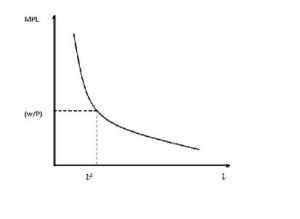
Optimizing Capital and Labor
In the long run, firms maximize profit by choosing the optimal combination of labor and capital to produce a given amount of output. It’s possible that an automobile company could manufacture 1,000 cars using only expensive, technologically advanced robots and machinery (capital) that do not require any human participation. It’s also possible that the company could produce the same number of vehicles using only employee work (labor), without any assistance from machines or technology. For most industries, however, relying solely on capital or solely on labor is more expensive than using some combination of the two.
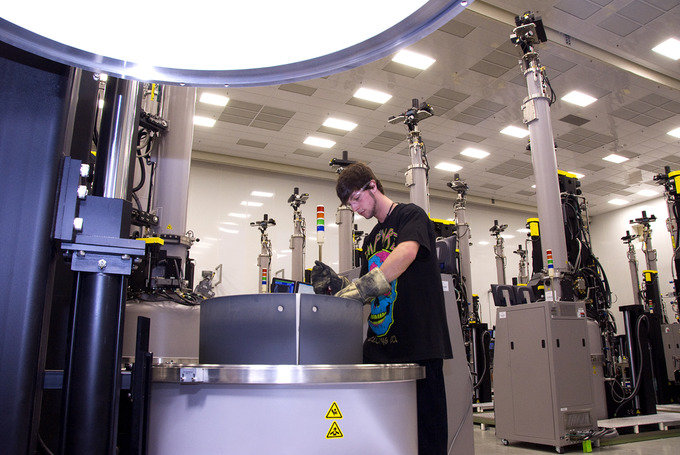
Firms use the marginal decision rule in order to decide what combination of labor, capital, and other factors of production to use in the creation of output. The marginal decision rule says that a firm will shift spending among factors of production as long as the marginal benefit of such a shift exceeds the marginal cost. Imagine that a firm must decide whether to spend an additional dollar on labor. To determine the marginal benefit of that dollar, we divide the marginal product of labor (MPL) by it’s price (the wage rate, PL): MPL/PL. If capital and labor are the only factors of production, then spending an additional $1 on labor while holding the total cost constant means taking $1 out of capital. The cost of that action will be the output lost from cutting back on capital, which is the ratio of the marginal product of capital (MPK) to the price of capital (the rental rate, PK). Thus, the cost of cutting back on capital is MPK/PK.
If the marginal benefit of additional labor, MPL/PL, exceeds the marginal cost, MPK/PK, then the firm will be better off by spending more on labor and less on capital. On the other hand, if MPK/PK is greater than MPL/PL, the firm will be better off spending more on capital and less on labor. The equilibrium – the point at which the firm is producing the maximum amount of output at a given cost – occurs where MPL/PL=MPK/PK.
The Wage Rate
The wage rate is determined by the intersection of supply of and demand for labor.
When labor is an input to production, firms hire workers. Firms are demand labor and workers provide it at a price called the wage rate. Colloquially, “wages” refer to just the dollar amount paid to a worker, but in economics, it refers to total compensation (i.e. it includes benefits).
The marginal benefit of hiring an additional unit of labor is called the marginal product of labor: it is the additional revenue generated from the last unit of labor. In theory, as with other inputs to production, firms will hire workers until the wage rate (marginal cost) equals the marginal revenue product of labor (marginal benefit).
Changes in Supply and Demand
In competitive markets, the demand curve for labor is the same as the marginal revenue curve. Thus, shifts in the demand for labor are a function of changes in the marginal product of labor. This can occur for a number of reasons. First of all, you can imagine that a new product or company is created that represents new demand for labor of a certain type. There are also three main factors that would shift the labor demand curve:
- Technology which affects the output of a unit of labor.
- Changes in the price of the output which affect the value of the unit of labor.
- Changes in the price of labor relative to other factors of production.
In the long run, the supply of labor is a function of the population. A decrease in the supply of labor will typically cause an increase in the wage rate. The fact that a reduction in supply tends to strengthen wages explains why unions and other professional associations have often sought to limit the number of workers in their particular industry. Physicians, for example, have a financial incentive to enforce rigorous training, licensing, and certification requirements in order to limit the number of practitioners and keep the labor supply low.
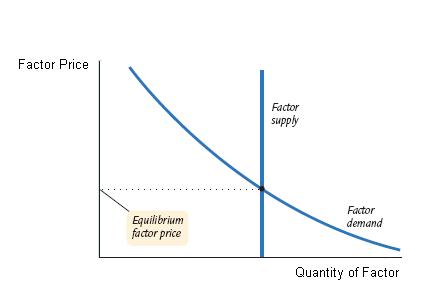
Compensation Differentials
Some differences in wage rates across places, occupations, and demographic groups can be explained by compensation differentials.
According to the basic theory of the labor market, there ought to be one equilibrium wage rate that applies to all workers across industries and countries. Of course this is not the case; doctors typically make more per hour than retail clerks, and workers in the United States typically earn a higher wage than workers in India. These wage differences are called compensation differentials and can be explained by many factors, such as differences in the skills of the workers, the country or geographical area in which jobs are performed, or the characteristics of the jobs themselves.
Education Differentials
One common source of differences in wage rates is human capital. More skilled and educated workers tend to have higher wages because their marginal product of labor tends to be higher. Additionally, the differential pay for more education tends to compensate workers for the time, effort, and foregone wages from obtaining the necessary training. If all jobs paid the same rate, for example, fewer people would go through the expense and effort of law school. The compensation differential ensures that individuals are willing to invest in their own human capital.

Geographic Compensation Differentials
If a certain part of a country is a particularly attractive area to live in and if labor mobility is perfect, then more and more workers will move to that area, which in turn will increase the supply of labor and depress wages. If the attractiveness of that area compared to other areas does not change, the wage rate will be set at such a rate that workers will be indifferent between living in areas that are more attractive but with a lower wage and living in areas which are more attractive with a higher wage. In this way, a sustained equilibrium with different wage rates across different areas can occur.
Discrimination and Compensation Differentials
In the United States, minorities and women make lower wages on average than Caucasian men. Some of this is due to historical trends affecting these groups that result in less human capital or a concentration in certain lower-paying occupations. Another source of differing wage rates, however, is discrimination. Several studies have shown that, in the United States, several minority groups (including black men and women, Hispanic men and women, and white women) suffer from decreased wage earning for the same job with the same performance levels and responsibilities as white males.
Compensating Differential
Not to be confused with a compensation differential, a compensating differential is a term used in labor economics to analyze the relation between the wage rate and the unpleasantness, risk, or other undesirable attributes of a particular job. It is defined as the additional amount of income that a given worker must be offered in order to motivate them to accept a given undesirable job, relative to other jobs that worker could perform. One can also speak of the compensating differential for an especially desirable job, or one that provides special benefits, but in this case the differential would be negative: that is, a given worker would be willing to accept a lower wage for an especially desirable job, relative to other jobs.

Performance and Pay
Theoretically there is a direct connection between job performance and pay, but in reality other factors often distort this relationship.
According to economic theory, workers’ wages are equal to the marginal revenue product of their labor. If one employee is very productive he or she will have a high marginal revenue product: one additional hour of their work will produce a significant increase in output. It follows that more productive employees should have higher wages than less productive employees. Imagine if this were not true: a firm decides to pay a highly productive worker less than the marginal revenue product of his labor. Any other firm could make a profit by offering a higher salary to attract the productive employee to their company, and the worker’s wage would rise. Theoretically, therefore, there is a direct relationship between job performance and pay.
We know that this is not always the case in reality. Wages are determined not only by one’s productivity, but also by seniority, networking, ambition, and luck. It is very rare for an entry-level worker to make the same wage as an experienced member of the same profession regardless of their relative levels of productivity because the older worker has had time to receive pay raises and promotions for which the younger employee is simply not eligible. Discrimination is sometimes responsible for members of minority racial or gender groups receiving wages that are less than wages for the majority group even when productivity levels are the same. Finally, outside forces, such as unions or government regulations, can distort pay rates.
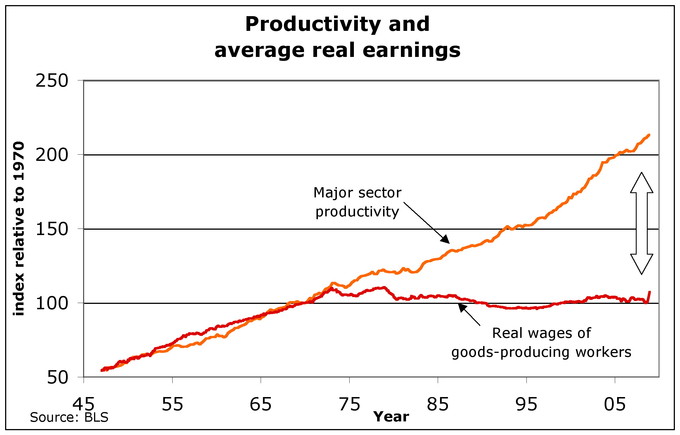
Linking Performance and Pay
Some of the disconnect between performance and pay can be addressed with alternate pay schemes. While a salary or hourly pay does not directly take into account the quality of work, performance-related pay compensates workers with higher levels of productivity directly. One example is commission-based pay. In this type of pay scheme, workers receive some percentage of the profit that they generate for their company. This may be paid on top of a baseline salary or may be the only form of compensation. This type of system is very common among car salespeople and insurance brokers.
Another alternative is piece-work, in which employees are paid a fixed rate for every unit produced or action performed, regardless of the time it takes. This is common in settings where it is easy to measure the output of piece work, such as when a garment worker is paid per each piece of cloth sewn or a telemarketer is paid for every call placed.
Marginal Revenue Productivity and Wages
In a perfectly competitive market, the wage rate is equal to the marginal revenue product of labor.
Just as in any market, the price of labor, the wage rate, is determined by the intersection of supply and demand. When the supply of labor increases the equilibrium price falls, and when the demand for labor increases the equilibrium price rises. In the long run the supply of labor is a simple function of the size of the population, so in order to understand changes in wage rates we focus on the demand for labor.
To determine demand in the labor market we must find the marginal revenue product of labor (MRPL), which is based on the marginal productivity of labor (MPL) and the price of output. Conceptually, the MRPL represents the additional revenue that the firm can generate by adding one additional unit of labor (recall that MPL is the additional output from the additional unit of labor). Thus, MRPL is simply the product of MPL and the price of the output.
The MPL is generally decreasing: adding a 100th unit of labor will not increase output as much as adding a 99th. Since competitive industries are price takers and cannot change the price of output by changing their level of production, the MRPL curve will have the same downward slope as the MPL curve.
From the perspective of the firm, the MRPL is the marginal benefit to the firm of hiring an additional unit of labor. We know that a profit-maximizing firm will increase its factors of production until their marginal benefit is equal to the marginal cost. Therefore, firms will continue to add labor (hire workers) until the MRPL equals the wage rate. Thus, workers earn a wage equal to the marginal revenue product of their labor. For example, in a perfectly competitive market, an employee who earns $20/hour has a marginal productivity that is worth exactly $20.

Changes in Equilibrium for Shifts in Market Supply and Market Demand
A shift in the supply or demand of labor will cause a change in the market equilibrium.
As in all competitive markets, the equilibrium price and quantity of labor is determined by supply and demand.
Labor Supply
Labour supply curves are derived from the ‘labor-leisure’ trade-off. More hours worked earn higher incomes but necessitate a cut in the amount of other things workers enjoy such as going to movies, hanging out with friends, or sleeping. The opportunity cost of working is leisure time and vis versa. Considering this tradeoff, workers collectively offer a set of labor to the market which economists call the supply of labor.
To see how changes in wages affect the supply of labor, suppose wages rise. This increases the cost of leisure and causes the supply of labor to rise – this is the substitution effect, which states that as the relative price of one good increases, consumption of that good will decrease. However, there is also an income effect – an increased wage means higher income, and since leisure is a normal good, the quantity of leisure demanded will go up. In general, at low wage levels the substitution effect dominates the income effect and higher wages cause an increase in the supply of labor. At high incomes, however, the negative income effect could offset the positive substitution effect and higher wage levels could actually cause labor to decrease. A worker making $800/hour who receives a raise to $1200/hour may not have much use for the extra money and may choose to work less while maintaining the same standard of living, for example. This creates a supply curve that bends backwards, initially increasing with the wage rate but later decreasing.
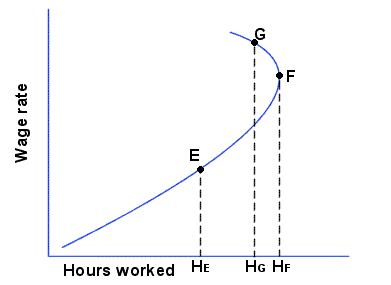
Figure 4.2h. Backward Bending Supply (Text Version)
The vertical axis is wage rate and horizontal axis is hours worked (H). The labour supply curve slopes upwards from left to right and curves backward. Three points occur progressively along the supply curve: Point E at HE occurs on the the upward trend of the curve, furthest to the left along the horizontal axis ; Point F at HF occurs next along the supply curve line in the bend, furthest to the right along the horizontal axis; and Point G at HG occurs last along the supply curve line where the line has bent backwards, occurs between point HE and HF along the horizontal axis.
Backward Bending Supply: While normally hours of labor supplied will increase with the wage rate, the income effect may produce the opposite effect at high wage levels.
People supply labor in order to increase their utility —just as they demand goods and services in order to increase their utility. The supply curve for labor will shift in response to changes in the same factors that shift demand for goods and services. These include changes in preferences, changes in income, changes in population, and changes in expectations. A change in preferences that causes people to prefer more leisure, for example, will shift the supply curve to the left, creating a lower level of employment and a higher wage rate.
Labor Demand
An increase in the demand for labor will increase both the level of employment and the wage rate. We have already seen that the demand for labor is based on the marginal product of labor and the price of output. Thus, any factor that affects productivity or output prices will also shift labor demand. Some of these factors include:
- Available technology (marginal productivity of labor)
- The skills or education of the workforce (marginal productivity of labor)
- Level of physical capital (marginal productivity of labor)
- Price of physical capital (price of output)
- Price of substitute or complement goods (price of output)
- Consumer preferences (price of output)
All of the above may cause the demand for labor to shift and change the equilibrium quantity and price of labor.
Labor Union Impacts on Equilibrium
Unions are organizations of workers that seek to improve working conditions and raise the equilibrium wage rate.
A labor union is an organization of workers who have banded together to achieve common goals. The primary activity of the union is to bargain with the employer on behalf of union members and negotiate labor contracts. The most common purpose of associations or unions is maintaining or improving the conditions of employment, which may include the negotiation of wages, work rules, complaint procedures, promotions, benefits, workplace safety, and policies.
In order to achieve these goals unions engage in collective bargaining: the process of negotiation between a company’s management and a labor union. When collective bargaining fails, union members may go on strike, refusing to work until a firm addresses the workers’ grievances.
Union Impacts on Equilibrium
Fundamentally, unions seek higher wages for its member workers (though, here “wages” encompasses all types of compensation, not just cash paid to the workers by the employer).
The effect of unions on the labor market equilibrium can be analyzed like any other price increase. If employers (those who demand labor) have an inelastic demand for labor, the increase in wages (the price of labor) will not translate into a drop in employment (quantity of labor supplied). If, however, their demand is elastic, employers will simply respond to union demands for higher wages by hiring fewer workers.
However, the reality of unions is more complex. As an organized body, unions are also active in the political realm. They can lobby for legislation that will affect the market not only for labor, but also for the goods they produce. For example, unions may advocate for trade restrictions to protect the markets in which they work from foreign competition. By preventing domestic firms from having to compete with unrestricted foreign firms, they can ensure that consumers do not have lower cost alternatives which would drive employers who pay a higher union wage out of business.

Key Points
- Firms will hire more labor when the marginal revenue product of labor is greater than the wage rate, and stop hiring as soon as the two values are equal.
- The point at which the MRPL equals the prevailing wage rate is the labor market equilibrium.
- The marginal decision rule says that a firm will shift spending among factors of production as long as the marginal benefit of such a shift exceeds the marginal cost.
- If the marginal benefit of additional labor, MPL/PL, exceeds the marginal cost, MPK/PK, then the firm will be better off by spending more on labor and less on capital.
- According to the marginal decision rule, equilibrium in the labor market must occur where MPL/PL=MPK/PK.
- An increase in demand or a reduction in supply will raise wages; an increase in supply or a reduction in demand will lower them.
- The demand curve depends on the marginal product of labor and the price of the good labor produces. If the demand curve shifts to the right, either because productivity or the price of output has increased, wages will be pushed up.
- In the long run the supply of labor is simply a function of the population size, but in the short run it depends on variables such as worker preferences, the skills and training a job requires, and wages available in alternative occupations.
- Although basic economic theory suggests that there ought to be one prevailing wage rate for all labor, this is not the case.
- Wage differences are called compensation differentials and can be explained by many factors, such as differences in the skills of the workers, the country or geographical area in which jobs are performed, or the characteristics of the jobs themselves.
- One common source of differences in wage rates is human capital. More skilled and educated workers tend to have higher wages because their marginal product of labor tends to be higher.
- If a certain area is a desirable place to live, the supply of labor will be higher than in other areas and wages will be lower. This is a type of geographical differential.
- Discrimination against gender or racial groups can cause compensation differentials.
- A compensating differential is the additional amount of income that a given worker must be offered in order to motivate them to accept a given undesirable job, relative to other jobs that worker could perform.
- According to economic theory, workers’ wages are equal to the marginal revenue product of their labor. If one employee is very productive he or she will have a high marginal revenue product.
- In reality, wages are determined not only by one’s productivity, but also by seniority, networking, ambition, and luck.
- Some of the disconnect between performance and pay can be addressed with alternate pay schemes.
- In the long run the supply of labor is a simple function of the size of the population, so in order to understand changes in wage rates we focus on the demand for labor.
- The marginal product of labor (MPL) is the increase in output that a firm experiences from adding one additional unit of labor.
- The marginal benefit to the firm of hiring an additional unit of labor is called the marginal revenue product of labor (MRPL). It is calculated by multiplying MPL by the price of the output.
- The MRPL represents the firm’s demand curve for labor, which means that the firm will continue to hire more labor until the MRPL is equal to the wage rate.
- The opportunity cost of leisure is the wages lost while not working; as wages rise, the cost of leisure increases.
- The substitution effect means that when wages rise, people are likely to substitute more labor for less leisure.
- However, the income effect means that as people become wealthier, their demand for normal goods such as leisure increases.
- Typically the substitution effect dominates the supply of labor at normal wage rates, but the income effect may come to dominate at higher wage rates. This creates a backward bending labor supply curve.
- The supply curve for labor will shift in response to changes in preferences, changes in income, changes in population, and changes in expectations.
- The demand curve for labor will shift in response to changes in human capital, changes in technology, changes in the price of complements or substitutes for output, and changes in consumer preferences.
- Unions ‘ primary work involves negotiating wages, work rules, complaint procedures, promotions, benefits, workplace safety and policies with company management.
- If the labor market is a competitive one in which wages are determined by demand and supply, increasing the wage requires either increasing the demand for labor or reducing the supply.
- Increasing demand for labor requires increasing the marginal product of labor or raising the price of the good produced by labor.
- Unions can restrict the supply of labor in two ways: slowing the growth of the labor force and promoting policies that make it difficult for workers to enter a particular craft.
Attribution
Except where otherwise noted, this chapter is adapted from “ Labor Market Equilibrium and Wage Determinants” In Economics (Boundless) via LibreTexts, shared under CC BY-SA 4.0. / Adapted by LibreTexts, originally published by Boundless, preserved by Lumen Learning. / Adaptations include adding key terms to glossary terms.
References from original source
- Labour economics. Provided by: Wikipedia. Located at: en.Wikipedia.org/wiki/Labour_economics. License: CC BY-SA: Attribution-ShareAlike
- marginal revenue product. Provided by: Wikipedia. Located at: en.Wikipedia.org/wiki/margina...enue%20product. License: CC BY-SA: Attribution-ShareAlike
- marginal product. Provided by: Wikipedia. Located at: en.Wikipedia.org/wiki/marginal%20product. License: CC BY-SA: Attribution-ShareAlike
- capital. Provided by: Wiktionary. Located at: en.wiktionary.org/wiki/capital. License: CC BY-SA: Attribution-ShareAlike
- Fator. Provided by: Wikipedia. Located at: en.Wikipedia.org/wiki/File:Fator.jpg. License: CC BY-SA: Attribution-ShareAlike
- All sizes | Solar wafer manufacturing | Flickr - Photo Sharing!. Provided by: Flickr. Located at: www.flickr.com/photos/oregond...n/photostream/. License: CC BY: Attribution
- Value of the Marginal Product. Provided by: Microecon201. Located at: Archived by the Internet Archive's WayBack Machine: https://web.archive.org/web/20130325002417/http://microecon201.wikispaces.com/Value+of+the+Marginal+Product. License: CC BY: Attribution
- Labor demand. Provided by: Wikipedia. Located at: en.Wikipedia.org/wiki/Labor_demand. License: CC BY-SA: Attribution-ShareAlike
- Wage. Provided by: Wikipedia. Located at: en.Wikipedia.org/wiki/Wage. License: CC BY-SA: Attribution-ShareAlike
- Labour economics. Provided by: Wikipedia. Located at: en.Wikipedia.org/wiki/Labour_(economics). License: CC BY-SA: Attribution-ShareAlike
- Union. Provided by: Wikipedia. Located at: en.Wikipedia.org/wiki/Union. License: CC BY-SA: Attribution-ShareAlike
- Factor compensation. Provided by: Wikipedia. Located at: en.Wikipedia.org/wiki/File:Fa...mpensation.jpg. License: CC BY-SA: Attribution-ShareAlike
- Compensating differential. Provided by: Wikipedia. Located at: en.Wikipedia.org/wiki/Compens...g_differential. License: CC BY-SA: Attribution-ShareAlike
- Economic discrimination. Provided by: Wikipedia. Located at: en.Wikipedia.org/wiki/Economi...discrimination. License: CC BY-SA: Attribution-ShareAlike
- differential. Provided by: Wiktionary. Located at: en.wiktionary.org/wiki/differential. License: CC BY-SA: Attribution-ShareAlike
- discrimination. Provided by: Wiktionary. Located at: en.wiktionary.org/wiki/discrimination. License: CC BY-SA: Attribution-ShareAlike
- Police Poland 2 AB. Provided by: Wikipedia. Located at: en.Wikipedia.org/wiki/File:Po...oland_2_AB.jpg. License: Public Domain: No Known Copyright
- Johns Hopkins University on Fotopedia. Provided by: Fotopedia. Located at: http://www.fotopedia.com/wiki/Johns_...ckr-4647211575. License: CC BY: Attribution
- Piece work. Provided by: Wikipedia. Located at: en.Wikipedia.org/wiki/Piece_work. License: CC BY-SA: Attribution-ShareAlike
- Performance-related pay. Provided by: Wikipedia. Located at: en.Wikipedia.org/wiki/Performance-related_pay. License: CC BY-SA: Attribution-ShareAlike
- commission. Provided by: Wiktionary. Located at: en.wiktionary.org/wiki/commission. License: CC BY-SA: Attribution-ShareAlike
- piece work. Provided by: Wiktionary. Located at: en.wiktionary.org/wiki/piece_work. License: CC BY-SA: Attribution-ShareAlike
- marginal benefit. Provided by: Wiktionary. Located at: en.wiktionary.org/wiki/marginal_benefit. License: CC BY-SA: Attribution-ShareAlike
- Factor market. Provided by: Wikipedia. Located at: en.Wikipedia.org/wiki/Factor_...et_(economics). License: CC BY-SA: Attribution-ShareAlike
- US productivity and real wages. Provided by: Wikimedia. Located at: commons.wikimedia.org/wiki/Fi...real_wages.jpg. License: Public Domain: No Known Copyright
- normal good. Provided by: Wiktionary. Located at: en.wiktionary.org/wiki/normal_good. License: CC BY-SA: Attribution-ShareAlike
- Labor economics. Provided by: Wikipedia. Located at: en.Wikipedia.org/wiki/Labour_Economics. License: CC BY-SA: Attribution-ShareAlike
- Labor supply. Provided by: Wikipedia. Located at: en.Wikipedia.org/wiki/Labour_supply. License: CC BY-SA: Attribution-ShareAlike
- Opportunity cost. Provided by: Wiktionary. Located at: en.wiktionary.org/wiki/Opportunity+cost. License: CC BY-SA: Attribution-ShareAlike
- Labour supply small. Provided by: Wikimedia. Located at: commons.wikimedia.org/wiki/Fi...pply_small.png. License: CC BY-SA: Attribution-ShareAlike
- collective bargaining. Provided by: Wiktionary. Located at: en.wiktionary.org/wiki/collective_bargaining. License: CC BY-SA: Attribution-ShareAlike
- Labor unions in the United States. Provided by: Wikipedia. Located at: en.Wikipedia.org/wiki/Labor_u..._United_States. License: CC BY-SA: Attribution-ShareAlike
- Trade union. Provided by: Wikipedia. Located at: en.Wikipedia.org/wiki/Trade_union. License: CC BY-SA: Attribution-ShareAlike
- strike. Provided by: Wiktionary. Located at: en.wiktionary.org/wiki/strike. License: CC BY-SA: Attribution-ShareAlike
- minimum wage. Provided by: Wiktionary. Located at: en.wiktionary.org/wiki/minimum_wage. License: CC BY-SA: Attribution-ShareAlike
- All sizes | Solar wafer manufacturing | Flickr - Photo Sharing!. Provided by: Flickr. Located at: http://www.flickr.com/photos/oregond...n/photostream/. License: CC BY: Attribution
- UnisonStrikeRallyOxford20060328 KaihsuTai. Provided by: Wikipedia. Located at: en.Wikipedia.org/wiki/File:Un..._KaihsuTai.jpg. License: Public Domain: No Known Copyright
Media Attributions
- factor © HpSSE is licensed under a CC BY-SA (Attribution ShareAlike) license
- Solar wafer manufacturing © Oregon Department of Transportation is licensed under a CC BY (Attribution) license
- Factor Compensation © HpSSE is licensed under a CC BY-SA (Attribution ShareAlike) license
- The Graduates © Sakeeb Sabakka is licensed under a CC BY (Attribution) license
- Polish police (riot contol squad) © Andrzej Barabasz (Chepry) is licensed under a CC BY-SA (Attribution ShareAlike) license
- Graph © U.S. Department of Labor, Bureau of Labor Statistics is licensed under a Public Domain license
- Graph © Maksim is licensed under a CC BY-SA (Attribution ShareAlike) license
- Photo © Kaihsu is licensed under a CC BY-SA (Attribution ShareAlike) license
Already-produced durable goods available for use as a factor of production, such as steam shovels (equipment) and office buildings (structures).
an organization of workers who have banded together to achieve common goals
a qualitative or quantitative difference between similar or comparable things
The extra output that can be produced by using one more unit of the input.
Distinct treatment of an individual or group to their disadvantage; treatment or consideration based on class or category rather than individual merit; partiality; prejudice; bigotry.
The change in total revenue earned by a firm that results from employing one more unit of labor.
A fee charged by an agent or broker for carrying out a transaction
Work that a worker is paid for according to the number of units produced, rather than the number of hours worked.
The extra benefit received from a small increase in the consumption of a good or service. It is calculated as the increase in total benefit divided by the increase in consumption.
The cost of any activity measured in terms of the value of the next best alternative forgone (that is not chosen).
A good in which the quantity demanded rises as income rises, and in which quantity demanded falls as income falls
A method of negotiation in which employees negotiate as a group with their employers.
A work stoppage (or otherwise concerted stoppage of an activity) as a form of protest.

